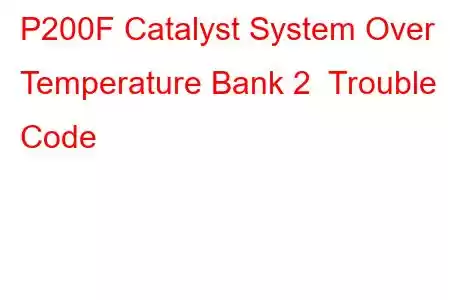P200F Catalyst System Over Temperature Bank 2
OBD-II Trouble Code Technical Description
Catalyst System Over Temperature Bank 2
What does that mean?
This diagnostic trouble code (DTC) is a generic powertrain code and applies to many OBD-II vehicles (1996-newer). That may include but is not limited to vehicles from Ford, Hino, Mercedes Benz, VW, etc. Although generic, the exact repair steps may vary depending on year, make, model and powertrain configuration.
If your diesel powered, OBD-II equipped vehicle has stored a code P200F, it means that the powertrain control module (PCM) has detected an excessive degree of catalyst system temperature for engine bank two. Bank 2 is the bank of the engine that doesn't contain the number one cylinder.
The catalyst system, as it pertains to a modern clean burning diesel powered vehicle, is designed to reduce harmful exhaust emissions before they can be released into the atmosphere. Exhaust emissions consist mainly of hydrocarbons (HC), carbon monoxide (CO), nitrogen oxide (NOx), and particulate matter (soot - in diesel applications). The catalytic converter is basically a large (fine mesh) filter that is capable of withstanding extreme temperature. Engine exhaust flows through and harmful emissions are trapped within a platinum filtration element. The extreme temperatures generated inside the catalytic converter help to burn harmful emissions elements.
The catalyst system is responsible for reduction of (basically) all the other exhaust emissions although certain applications are also equipped with a NOx trap.
Exhaust gas recirculation (EGR) systems go another step further in the reduction of NOx. Nevertheless, today’s larger and more powerful diesel engines cannot meet strict federal (U.S.) emission standards with the EGR, catalytic converter, and NOx trap alone. It was for this reason that selective catalytic reduction (SCR) systems were invented.
SCR systems inject diesel exhaust fluid (DEF) into the exhaust in front of the diesel particulate filter and/or the catalytic converter. The precisely timed DEF injection elevates the temperature of the filtration element and allows it to perform more efficiently. It makes the filtration element last longer and allows fewer harmful exhaust emissions to be released into the atmosphere.
Exhaust temperature sensors are placed before and after the catalyst to monitor its temperature and efficiency. The entire SCS system is monitored and controlled by either the PCM or a stand-alone controller (which interacts with the PCM). Either way, the controller monitors the O2, NOx, and exhaust temperature sensors (as well as other inputs) to determine the appropriate time for DEF injection. Precise DEF injection is necessary to maintain exhaust temperature within acceptable parameters and optimize pollutant filtration.
If the PCM detects excessive catalyst system temperature (for engine bank two), a code P200F will be stored and a malfunction indicator lamp may be illuminated.
A cutaway of a typical diesel particulate filter:
What is the severity of this DTC?
Any stored catalyst system codes may be precursor to a clogged exhaust system. The stored code P200F should be considered severe and addressed as quickly as possible. Catalyst damage could result if the conditions which contributed to the code being stored are not rectified in a timely manner.
What are some of the symptoms of the code?
Symptoms of a P200F trouble code may include:
Diminished engine performance Excessive black smoke from vehicle exhaust Reduction in fuel efficiency Other emission related codesWhat are some of the common causes of the code?
Causes for this code may include:
Inoperative SCR system Faulty SCR injector Incorrect or insufficient DEF fluid Defective exhaust temperature sensor Bad SCR controller or programmingRead: 30


